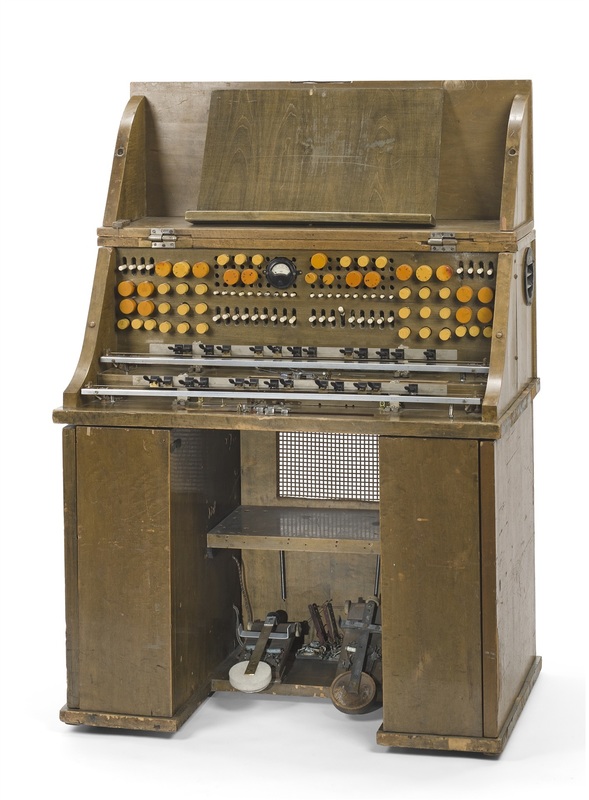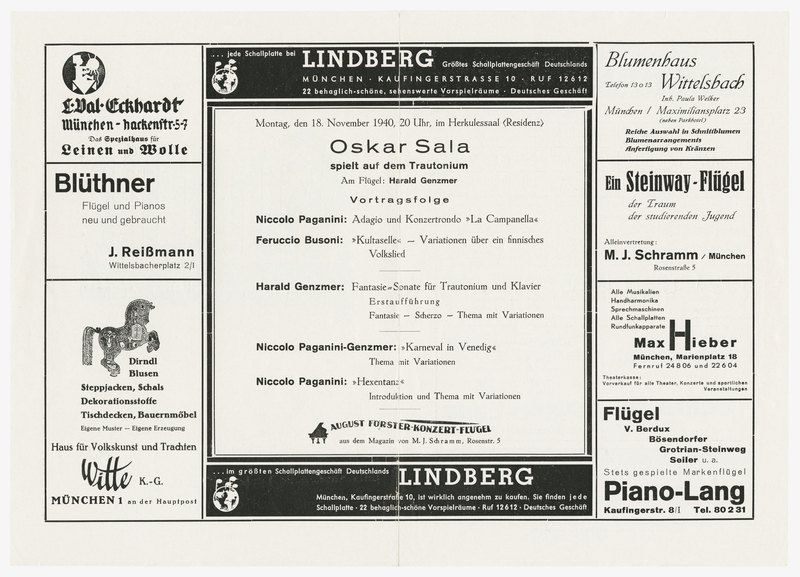The Trautonium on tour
In order to meet the demands of touring with his instrument, Sala built a transportable counterpart to the Rundfunktrautonium: the Konzerttrautonium. The Konzerttrautonium first premiered on air in 1939 via the broadcasting station Deutschlandsender and made its first live appearance on October 28, 1940 in a special concert for contemporary music by the Berlin Philharmonic Orchestra, in which Sala performed Harald Genzmer’s Trautoniumkonzert.[10]
The following concert programme provides insight into the kind of music Sala performed on both the Rundfunktrautonium and the Konzerttrautonium.
In corroboration with Sala’s examples of composers whose works he played for radio, the concert programme includes two excerpts from Niccolò Paganini’s Violin Concerto No. 1, Op. 6 (1816) and No. 2, Op. 7 (1826) respectively: the second movement (Adagio) and the third movement (Rondo, nicknamed La Campanella). The juxtaposition of these two movements was indeed a strategic choice: the slow movement allowed Sala to flaunt the expressive and warm vibrato feature afforded by the instrument’s string manual, countering criticism often levelled at the cold and inexpressive tones of many new electric instruments. On the other hand, the lively Rondo presented Sala with the opportunity to dazzle the audience by executing a well-known and highly difficult piece for the violin. According to the programme notes, Sala chose to undertake “sonic changes” and “virtuosic additions” which he claimed were only executable on the Trautonium.[11] These included the execution of several tutti passages and the eponymous little bells on the Trautonium. Thus, Sala could display the timbral diversity of his instrument as well as deliver an arrangement of the piece that surpassed what was playable on the original instrument, the violin.
The programme also reveals that Harald Genzmer’s Fantasie – Sonate, written specifically for Trautonium and piano, was premiered at the Munich Residence in 1940. Regarding Genzmer’s piece, Sala emphasized that it was not intended as a demonstrative piece for the Trautonium. Rather, Sala underscored the service of the instrument to the composer and his inspiration, serving as a facilitator or “prerequisite for the unimpeded unfolding of [the composer’s] creative fantasy.”[12] Nevertheless, it is not beyond reasonable doubt that Genzmer was to some degree inspired by the novel features of the Trautonium and was compelled to compose a piece that could take advantage of these features. Genzmer accompanied Sala on at least four other occasions: in Vienna, Berlin Dresden and Florence.
In 1944, Sala was conscripted into the German armed forces and sent to the Eastern Front.[13]
Citation: Julin Lee, ‘Subharmonic Fantasias: The Legacy of Oskar Sala and the Mixturtrautonium’, in: Materiality of Musical Instruments. A Virtual Exhibition.


